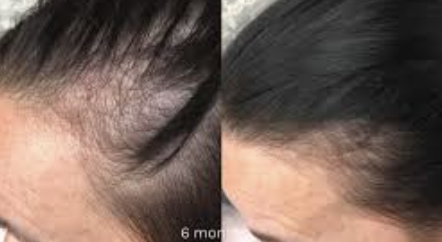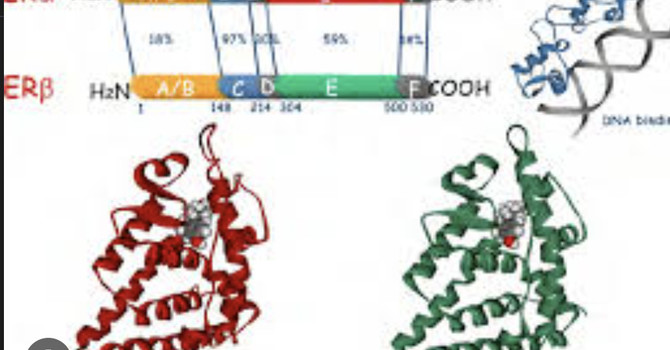
Hair loss is a common yet often overlooked symptom of menopause. Up to 50% of postmenopausal women report some degree of hair thinning or shedding, often concentrated at the crown or part line. These changes are not purely cosmetic—they reflect shifts in hormonal balance, nutrient status, and overall metabolic function.
Female Pattern Hair Loss (FPHL)
The most common type of hair loss in menopause is Female Pattern Hair Loss (FPHL). It is characterized by gradual thinning and miniaturization of the hair follicles, leading to finer, shorter hairs and decreased scalp coverage over time. This condition is hormonally mediated and tends to be progressive without intervention.
The drop in estrogen and progesterone during menopause disrupts the normal hair cycle, pushing more hairs into the shedding (telogen) phase and shortening the growth (anagen) phase. As estrogen declines, androgens such as testosterone and its more potent form, DHT (dihydrotestosterone), become more dominant. In genetically predisposed women, this can accelerate follicle miniaturization.
Additional Contributors to Hair Loss
-
Telogen Effluvium: A temporary form of diffuse shedding often triggered by illness, stress, surgery, medication changes, or hormonal transitions. It typically resolves within 3 to 6 months but can overlap with FPHL.
-
Thyroid Dysfunction: Both hypothyroidism and hyperthyroidism can cause diffuse hair thinning. Thyroid disorders are common during perimenopause and menopause.
-
Insulin Resistance and PCOS: Insulin dysregulation can increase circulating androgens, contributing to scalp hair thinning and unwanted facial hair. Women with a history of PCOS are particularly vulnerable to this pattern.
-
Nutritional Deficiencies: Iron (particularly ferritin), vitamin D, selenium, and iodine deficiencies can all impair hair growth. These should be evaluated and corrected when clinically appropriate.
-
Reduced Scalp Circulation: Estrogen promotes vascularization; its loss can decrease blood flow to the scalp and limit delivery of nutrients and oxygen to hair follicles.
Evaluation
Evaluation should focus on identifying correctable contributors:
-
Thyroid Testing (TSH, T3, T4)
-
Iron Studies, especially ferritin (levels under 30–40 ng/mL may indicate increased shedding)
-
Vitamin D, selenium, and iodine status
-
Metabolic screening, particularly in the presence of PCOS or elevated BMI
Extensive hormone panels are not typically necessary unless symptoms warrant. Treatment decisions are guided by clinical presentation and therapeutic response.
Treatment Strategies
Hormonal Support
Bioidentical hormone therapy with estrogen and progesterone may help stabilize the hair cycle in some women, particularly when started near the onset of menopause. This can improve hair quality as well as other systemic symptoms.
Testosterone and DHEA Supplementation
In select cases, supplementation with testosterone and DHEA may support hair regrowth, energy, and tissue repair. These androgens must be dosed precisely to minimize the risk of unwanted side effects, including facial hair or acne.
Laser Cap Therapy (Low-Level Laser Therapy)
LLLT is a drug-free option that uses light therapy to stimulate blood flow to the scalp and support follicle activity. Consistent use may slow the progression of FPHL and enhance regrowth over time.
Nutritional Correction
Deficiencies in iron, vitamin D, selenium, and iodine should be addressed. Diet and lifestyle strategies aimed at improving insulin sensitivity are especially important in women with metabolic risk factors or PCOS.
Minoxidil: Topical and Oral
Minoxidil enhances follicular blood supply and prolongs the anagen phase. It is available as a topical application and in low-dose oral formulations, the latter used off-label for women who do not respond to or tolerate topical treatments. Both options should be monitored for potential cardiovascular side effects.
Conclusion
Menopausal hair loss is a multifactorial condition influenced by hormones, metabolic health, and nutrient status. Early recognition and a personalized, layered approach to treatment—including hormonal support, laser therapy, targeted supplementation, and minoxidil—can significantly improve outcomes.
Dr. Anat Sapan MD, specializing in peri/menopause care, advocates for a personalized approach combining Bioidentical Hormone Replacement Therapy with lifestyle strategies. Her telemedicine services in Arizona, California, Florida, Illinois, New York and Arizona. I aim to help women overcome menopausal symptoms and enhance their quality of life.

Anat Sapan, MD
Contact Me



